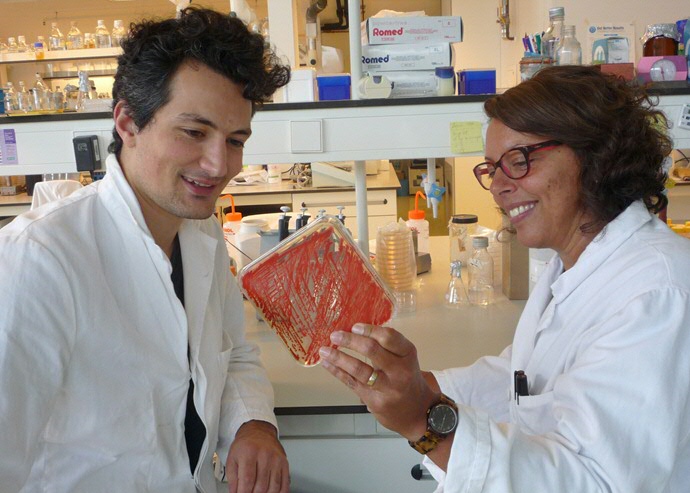Ook invasies van micro-organismen volgens de regels der ecologie

Wetenschappers van de Rijksuniversiteit Groningen hebben ontdekt dat invasies van micro-organismen dezelfde algemene patronen volgen als invasies van planten of dieren. Dit is een voorbeeld van de manier waarop de microbiële wereld de algemene regels van de ecologie volgt. Die ontdekking toont aan dat micro-organismen bruikbaar zijn om ecologische en evolutionaire vraagstukken te onderzoeken, maar heeft ook belangrijke gevolgen voor het begrijpen en behandelen van infectieziekten. De bevindingen zijn gepubliceerd in een overzichtsartikel dat is verschenen in het oktobernummer 2015 van het tijdschrift Trends in Microbiology.
Het klinkt misschien raar, maar tot een aantal jaren geleden gingen biologen er niet vanuit dat micro-organismen een ‘invasie’ konden uitvoeren. Ze veroorzaken natuurlijk infecties maar in ecologische termen spreek je pas van een ‘invasie’ als een soort zich in een nieuw gebied weet te vestigen, waar die soort eerder niet aanwezig was. ‘En tot voor kort was het idee dat alle micro-organismen overal voorkwamen en dat alleen selectie van de omgeving bepaalde welke soorten dominant waren’, legt Cyrus Mallon uit. Hij promoveerde onlangs bij de onderzoeksgroep Microbiële Ecologie van het Groningen Institute for Evolutionary Life Sciences (GELIFES).
Biogeografisch patroon
Dit microbiologische paradigma stamt nog uit de tijd dat bacteriën vooral werden geïdentificeerd onder de microscoop, met gebruikmaking van klassieke technieken die beperkte informatie opleverden. Zelfs toen DNA-technieken in zwang kwamen om micro-organismen te determineren, werd dit doorgaans gedaan met behulp van een specifiek ribosomaal gen. Pas toen wetenschappers de DNA-volgorde van verschillende genen gingen gebruiken om de samenstelling van microbiologische gemeenschappen te onderzoeken, bleek dat er wel degelijk een biogeografisch patroon zichtbaar was in de verspreiding van soorten. Daaruit volgde de conclusie dat micro-organismen wel degelijk invasies konden uitvoeren.
Nieuwe inzichten
Dit nieuwe idee zorgde voor een reeks aan nieuwe onderzoeken naar microbiologische invasies die de afgelopen jaren zijn gepubliceerd. Mallon analyseerde de recente literatuur samen met professor Jan Dirk van Elsas en associate professor Joana Falcão Salles, om op basis hiervan een beeld te schetsen van microbiële invasies. Hun overzichtsartikel levert twee nieuwe inzichten op: Het eerste is dat microbiële invasies hetzelfde patroon volgen als invasies van dieren of planten. Het tweede inzicht is dat een diversiteit aan soorten de beste verdediging is tegen invasies.
Koeienvlaai
Mallon: ‘Op basis van de literatuur konden we vier verschillende fasen in een invasie definiëren: introductie, consolidatie, verspreiding en impact.’ Die fasen zijn identiek aan de fasen in een invasie van planten- of dierensoorten. Zo’n invasie vindt plaats wanneer micro-organismen een nieuwe omgeving bereiken. ‘Oceaanstromingen kunnen micro-organismen bijvoorbeeld verspreiden naar nieuwe locaties, maar er is ook bewijs dat ze via de lucht reizen. Micro-organismen die naar alle waarschijnlijkheid afkomstig zijn uit de Gobi-woestijn zijn gevonden in luchtmonsters genomen in het noordwesten van de VS.’ En een meer zichtbare vorm van een invasie is wanneer darmbacteriën het bodemleven van een weide bereiken via een koeienvlaai.
Diversiteit is barrière
Een synthese van een groot aantal experimenten met microbiële invasies laat zien dat de diversiteit van de al aanwezige bacteriële gemeenschap een barrière vormt tegen invasies. En hoewel diversiteit de weerstand tegen invasies goed kan voorspellen, blijkt het mechanisme vooral te liggen in het vermogen van de aanwezige soorten om veel verschillende voedselbronnen te gebruiken, waardoor nieuwe soorten maar moeilijk aan voldoende voedingsstoffen kunnen komen.
Modelorganisme
Deze inzichten kunnen verstrekkende gevolgen hebben, zegt Falcão Salles: ‘Nu blijkt dat microbiële ecologie dezelfde regels lijkt te volgen als algemene ecologie zou je micro-organismen als model kunnen gebruiken voor ecologische experimenten.’ Dankzij hun korte generatietijd levert dit veel sneller resultaten op.
Medisch
Daarnaast is een beter theoretisch begrip van microbiële invasies van belang voor medisch onderzoek. Salles: ‘Een ziekteverwekkende salmonellasoort stimuleert bijvoorbeeld de darm om specifieke voedingsstoffen af te scheiden waardoor deze bacterie in het voordeel is vergeleken met andere darmbacteriën. We zouden zo’n infectie wellicht kunnen bestrijden door een onschadelijke bacterie zo aan te passen dat deze het voedsel voor de salmonella wegkaapt.’
Pro- en prebiotica
Bovendien kan de kennis over hoe bacteriën een nieuwe omgeving koloniseren helpen bij de ontwikkeling van nieuwe probiotica of prebiotica die zorgen voor een gezonde samenstelling van de bacteriegemeenschap in de darmen. ‘We weten dat er tal van mogelijke toepassingen zijn, maar in dit stadium moeten we nog uitvinden welke daarvan het beste werken.’
Meer informatie
Referentie: Microbial invasions: the process, patterns, and mechanisms . Cyrus Alexander Mallon , Jan Dirk van Elsas, Joana Falcão Salles. Trends in Microbiology, 1 oktober 2015
Meer nieuws
-
11 december 2025
Stormachtige planeten en een onverwachtse atmosfeer
-
09 december 2025
RUG-hoogleraar bij COP30: ‘Het is altijd drama’
